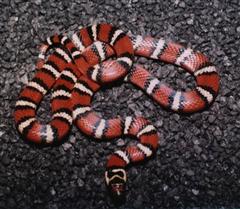Kingsnake - Coastal mountain
California Mountain King Snake Scientific Name: Lampropeltis zonata multifasciata
Fri, 4th July, 2025 - 7:58 am GMT
Sponsor Ads:

Alternative Name
California Mountain King Snake Scientific Name: Lampropeltis zonata multifasciataBasic Info
Rarely exceeding thirty inches in length, the Coastal Mountain Kingsnake is a small snake. They have smooth scales in a pattern of alternating white, red, and black bands. They resemble the Coral Snake and Sonoran Mountain Kingsnake, although these snakes do not appear in California.
Health
Zonata are a small Kingsnake that requires average Lampropeltis care. With their size, a 15-gallon long tank should do fine for an adult. As it is a mountain king ranging from California, Oregon, Washington, and down into Baja CA, it likes temperatures that are slightly lower than some other Kingsnakes. An under-tank heater, with a thermostat to adjust temperature, can be used. Maintain temperatures between 84 and 85 degrees Fahrenheit. Keep on a bedding of Aspen shaving (about 1-2 inches thick). Place few cork bark pieces or other forms of hiding in the tank. A water bowl large enough for it to soak in is needed; clean and refill daily. Feeding is the tricky part. With captive bred individuals, feeder mice of right size should be fed. If the animal is wild-caught, it might refuse rodents. Keep trying different methods. Please note that Zonata are a protected species in California. Please review any rules/laws that might be involved in the ownership of this species.Habitat
Usually makes its home near brooks and streams in humid forests especially pine forestsBehavior
The Coastal Mountain Kingsnake is a rare snake that is also known as the California Mountain Kingsnake. The Coastal Mountain Kingsnake usually makes its home near brooks and streams in humid forests especially pine forests. They are carnivorous, and like other Kingsnakes, are constrictors. In the wild, Coastal Mountain Kingsnakes feed primarily on small vertebrates. They usually eat salamanders, lizards, and other snakes. The Coastal Mountain Kingsnake even preys on Rattlesnakes.Origin
Central AmericaHistory
A rare animal, the Coastal Mountain Kingsnake exists only in Northern Baja California, California, and Southern Oregon. There is a small population in northern central Oregon and south central Washington. Because they so closely resemble the poisonous Coral Snake, they are often killed by humans who mistake it for the venomous animal.Common Foods
feeds on lizards, birds, snakes, eggs, frogs, lizards and small mammalsSponsor Ads:
In America, the Secretary of Agriculture catches hell for unmanageable food surpluses; in Russia, his counterpart goes to Siberia because of unmanageable food shortages. -- Unknown
Kingsnake - Coastal mountain
Coded by: BGID® | ALL RIGHTS RESERVED Copyright © 2000-2025
Disclaimer | Privacy | Report Errors / Contact | Credits








 Why haven't we as a collective earth met with aliens yet?
Why haven't we as a collective earth met with aliens yet?  World EcoSystem - Biodiversity Changes - Who is on board and who isn
World EcoSystem - Biodiversity Changes - Who is on board and who isn  Homosexual behavior stems from the mind or genetics?
Homosexual behavior stems from the mind or genetics?  The Best Text Adventure You Will Ever Play! The official site:
The Best Text Adventure You Will Ever Play! The official site:  Mouthwash - Mouthrinse - Mouth Sores - Healing Infections - Gingivitis
Mouthwash - Mouthrinse - Mouth Sores - Healing Infections - Gingivitis  Treatment for Depression
Treatment for Depression  Ultra radical and violent Islamist group that even rivals Al Qaeda
Ultra radical and violent Islamist group that even rivals Al Qaeda  An idea to have teachers who want to carry guns to school undergo some level of police training will be left up to local school districts and police departments.
An idea to have teachers who want to carry guns to school undergo some level of police training will be left up to local school districts and police departments.